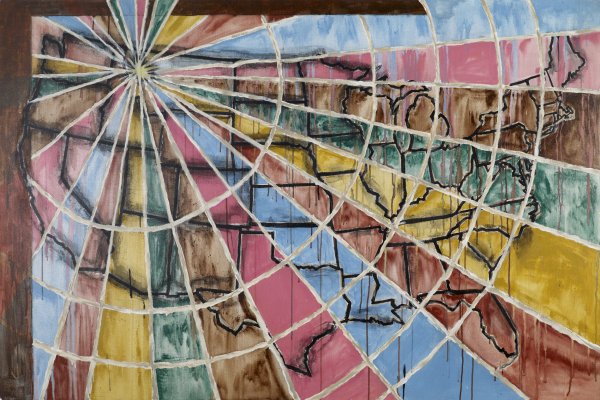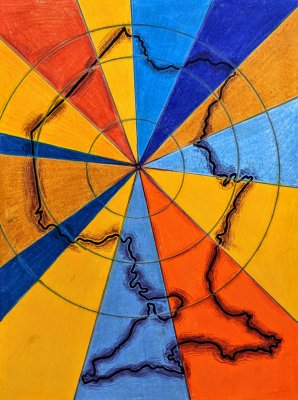Materials
- Paper
- Pencil
- Dark colored pen or marker
- Coloring tools (crayons, markers, colored pencils, etc.)
- Different sized objects for tracing circles (soup can, coffee mug, candle, water bottle, pencil holder, etc.)
- A map of your city, town, county, or state (you can look at an image online or use a map)
- Ruler (optional)
Vocabulary
Map: drawing of all or part of Earth's surface; its basic purpose is to show where things are; it is usually on a flat surface
Discussion and Video
Begin by using the Teaching Tips and Tools for Discussion. An example of how to bring in information about the artist from something your students observed: If they observed that it looks like the center of the artwork is in the upper left, you can share that is where the artist grew up, so that is where she wanted to put her center of the map.
When looking at the artwork, have the students trace in the air the lines that they see. Explain that the curved lines are just a part of a circle and see if they can make up the rest of the circle in the air with hand movements.
Next, watch the following video:
In the video, Smith says she likes to use maps in her art because “maps can tell stories.”
Ask the following questions to begin a discussion with your students:
- What story would you want to share? Where does that story take place?
- For older students: Jaune Quick-to-See Smith was told that she could never be an artist because she was a girl. Do you think that was fair for someone to say to her? What do you think about her becoming an artist anyway?
If you are not able to watch the video, we suggest showing a picture of the artist before moving on to the project. When students see an image of the artist, especially if the artist is still alive, it helps them to see that art is being made by all types of people from all over the world.
Artmaking
Overview: This activity is to encourage young students to create their own drawing that is inspired by Jaune Quick-to-See Smith’s use of maps, bright colors, and circles.
- To begin, show your students a map. Depending on the locations of your students, you can display a map of the city, town, county, or state that they all live in. Ask them to draw the outline onto their paper with a pencil then go back over their line with a pen or marker.
- Next, ask the students to pick out three to four objects for tracing circles (see materials list for ideas). Have them look at the bottoms of the objects and put them in order from smallest to biggest. (Try to make sure the smallest one is a bit smaller than their drawing from the first step.) It’s OK if part of the circles go off the page.
- Ask each student to pick out a color that they really like from their coloring tools and put a dot in the middle of their drawing. Show how to trace the smallest object, making sure to cover the dot. Then they should trace each object, from smallest to biggest, with their dot in the center of each circle. (It’s OK if it’s not perfect! Wobbly circles add some fun.)
- Next, ask the students to trace a few lines starting at their dot and ending at the edge of their paper. They can use a ruler or draw the lines on their own.
- Once they have drawn their circles and lines, they are ready to add color. Ask the students to think about what colors they want to use. Do they want to use many different colors or just a few? Ask them to look back at Smith’s work for inspiration.

